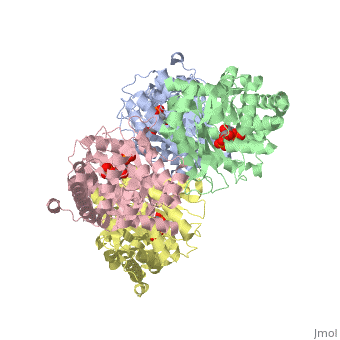3mmt
From Proteopedia
Crystal structure of fructose bisphosphate aldolase from Bartonella henselae, bound to fructose bisphosphate
Structural highlights
FunctionEvolutionary ConservationCheck, as determined by ConSurfDB. You may read the explanation of the method and the full data available from ConSurf. Publication Abstract from PubMedFructose bisphosphate aldolase (FBPA) enzymes have been found in a broad range of eukaryotic and prokaryotic organisms. FBPA catalyses the cleavage of fructose 1,6-bisphosphate into glyceraldehyde 3-phosphate and dihydroxyacetone phosphate. The SSGCID has reported several FBPA structures from pathogenic sources, including the bacterium Brucella melitensis and the protozoan Babesia bovis. Bioinformatic analysis of the Bartonella henselae genome revealed an FBPA homolog. The B. henselae FBPA enzyme was recombinantly expressed and purified for X-ray crystallographic studies. The purified enzyme crystallized in the apo form but failed to diffract; however, well diffracting crystals could be obtained by cocrystallization in the presence of the native substrate fructose 1,6-bisphosphate. A data set to 2.35 A resolution was collected from a single crystal at 100 K. The crystal belonged to the orthorhombic space group P2(1)2(1)2(1), with unit-cell parameters a = 72.39, b = 127.71, c = 157.63 A. The structure was refined to a final free R factor of 22.2%. The structure shares the typical barrel tertiary structure and tetrameric quaternary structure reported for previous FBPA structures and exhibits the same Schiff base in the active site. Structure of fructose bisphosphate aldolase from Bartonella henselae bound to fructose 1,6-bisphosphate.,Gardberg A, Abendroth J, Bhandari J, Sankaran B, Staker B Acta Crystallogr Sect F Struct Biol Cryst Commun. 2011 Sep 1;67(Pt, 9):1051-4. Epub 2011 Aug 13. PMID:21904049[1] From MEDLINE®/PubMed®, a database of the U.S. National Library of Medicine. See AlsoReferences
| ||||||||||||||||||||


